Unconventional Growth: How 10 Companies Succeeded by Ignoring Marketing “Wisdom”
Everyone has an opinion (just check out the dozens of “Opinions are like [blank]” memes to see what I mean). Some you agree with, others you strongly oppose, and still others you feel indifferent about.
Sometimes those opinions are so successful and popular that they become accepted as an absolute truth over time. They transform from “just” an opinion into conventional wisdom.
Ignore it at your peril. It’s not called wisdom for nothing.
But is that always true? It seems that for every piece of conventional wisdom, there’s at least one example of someone thriving while doing the opposite. In fact, for many people, conventional wisdom dictates that you should ignore conventional wisdom.
“Swim upstream. Go the other way. Ignore the conventional wisdom.” ~Sam Walton, founder of Walmart
We tend to accept conventional wisdom because it’s battle-tested. It’s survived the test of time. How can it be wrong if so many people believe it?
The answer lies in the question itself. We believe it because so many others do…often in the face of compelling evidence to the contrary.
In business. In finance. And in life in general. There are many instances where the accepted wisdom is either outdated, off-base, or just plain wrong. Yet still it persists because it’s hard to change the minds of so many people.
To buck the trend, you need to be brave. You need to be a risk-taker. You need to be willing to fail spectacularly. But as “they” say, without risk there is no reward.
It makes sense. If you want to stand out, you need to approach or think or do something differently than everyone else. Let the masses toe the line; you need to step over it.
Conventional marketing wisdom should be considered a solid suggestion at best. While much of it is reliably and consistently powerful – build a blog, segment your audience, include a content strategy, and so on – some of it can be safely ignored.
Want more proof? Consider these 10 companies that succeeded by ignoring marketing “wisdom.”
1. Avis
No one wants to be the silver medalist, the runner-up. We’re taught to strive for the top of the podium. Anything less is failure.
Except for car rental company Avis. They revel in being the second (or third) best. They proudly shout from the rooftops, “We’re #2!”.
The conventional wisdom: Advertising is all about making yourself look like the best choice, even if it means bending the truth.
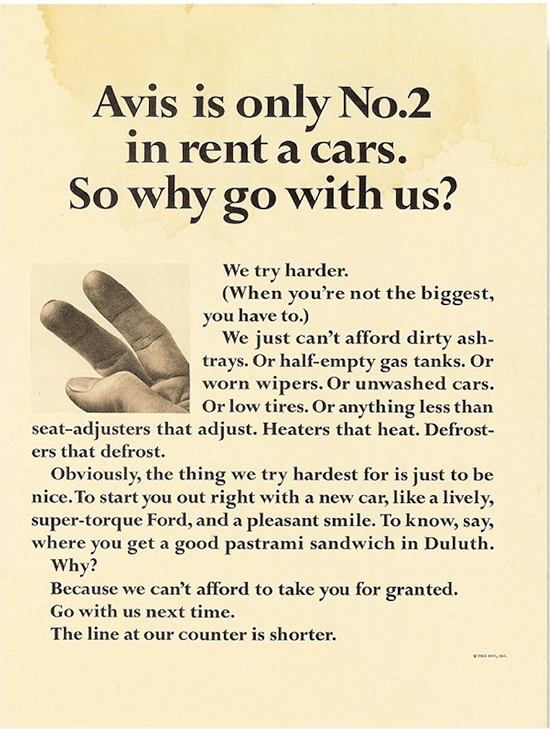
Image courtesy of Avis
The auto rental market in the U.S. is expected to be worth $79.4 billion by 2019, and while Avis is considered a major player in the industry, they’ve never been the top dog. And that’s A-OK with them.
In fact, starting in 1962, Avis took the unprecedented approach of advertising their second-place status in their iconic “We’re No. 2. We try harder.” campaign. “We try harder” remained the company’s motto for the next 50 years.
It’s a classic example of brutal truth in advertising, and it resonated with consumers. Avis went from losing $3.2 million to a profit of $1.2 million in a single year.
It worked in 1962, and it would likely work today. People are looking for that kind of honesty and connection with companies. With Avis, it was a promise to go beyond and try harder because they couldn’t afford to take customers for granted or get complacent with their status.
The rental market has grown, and the competition is fierce. Today, Avis is no longer number two. They’re number three behind Enterprise and Hertz. But in an industry worth billions, that’s not exactly a bad place to be. They got there – and remain there – with an unconventional approach: honesty in marketing.
That, and a promise of shorter lines at the counter (being less popular does have its advantages).
2. Timothy Sykes
It’s important to be liked. In fact, it’s one of Cialdini’s six weapons of influence. It’s easier to get people to agree with and do what you ask them to do if they genuinely like you.
Enter Timothy Sykes. He rose to fame by making millions in day trading penny stocks while skipping classes at university. He’s written books on trading and investing, and currently works as a financial activist and educator.
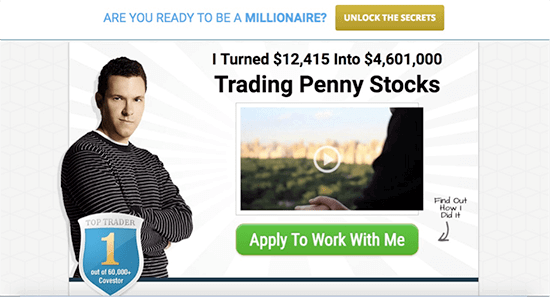
And most people think he’s a bit of a jerk.
The conventional wisdom: The face of your brand needs to be likeable and appeal to all consumers.
Sykes doesn’t appeal to the masses. His persona is that of a showoff. A braggart. He shares pictures of his vacations, and homes, and cars, and stacks of cash, and clothes, and luxury watches, and his earnings on social media.
He highlights his lifestyle in order to build his personal brand.
“I play the role of the rich douche bag.” ~Tim Sykes
Timothy Sykes sells advice and monthly subscriptions on his website. His online persona – even if it’s the opposite of Sykes in real life – helps to attract the type of people looking to get rich (and the quicker the better) using his system and tips. He’s brash and in-your-face…but that appeals to his target.
A nice, polite man asking you to subscribe to his penny stock newsletter? Maybe. A jerk sitting on the hood of his $200,000 car while lighting a cigar with a $100 bill with a beautiful woman draped around him? Yes, please (or so it would seem).
Whatever the reason, the approach works for Sykes, as it did for others like Tucker Max and Maddox.
In business, it’s usually best to be nice. Likeable. But sometimes, you need to portray a different image to appeal to your target audience. Does it always work? Absolutely not.
But it can. Just ask Tim…who’s apparently a sweetheart in real life, and donates much of his time and money to various charities.
Just don’t tell his audience.
3. Top Hat Inc.
Top Hat is hoping to change the 21st century classroom, promising to transform “students into experts and profs into heroes.”
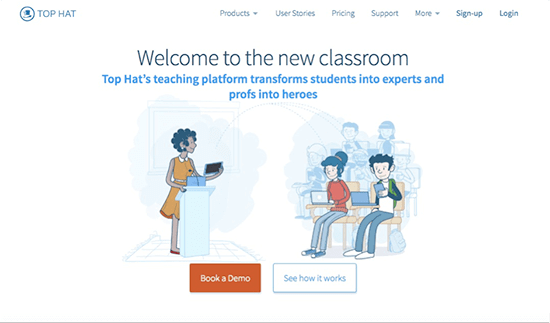
Their cloud-based software includes the tools to make lectures and textbooks more interactive and engaging, and provides a wealth of secondary resources to enhance and expand learning.
Sounds like it sells itself, right? Principals, superintendents, and post-secondary administers would quickly recognize the potential and sign on for the service.
The conventional wisdom: If you want to sell your product, start with the people at the top.
Co-founder and CEO Mike Silagadze bought into the traditional advice, too. And for his early efforts pitching those at the top? Zilch. Nothing. Not a single bite.
Not one individual at the top signed up in the first month after their official launch. They needed a different approach.
So instead of going after the decision-makers at the apex – as traditional marketing wisdom dictates – they shifted their focus to the students and teachers themselves. Instead of sending salespeople to visit the administrators, they targeted those who would actually be using the system directly via online devices.
This unconventional marketing strategy lets them communicate directly with users, offer unparalleled customer and tech support, and the ability to scale up quickly and easily as necessary.
By ignoring conventional wisdom, Top Hat has grown by over 5000% in five years, and currently has roughly 2 million students at 750 schools in the United States and Canada.
4. Ben & Jerry’s
Cherry Garcia. Chunky Monkey. Americone Dream. Coffee, Coffee BuzzBuzzBuzz.
You know ‘em. You love ‘em. They’re Ben & Jerry’s ice cream flavors.
The two fellas from Vermont are kind of the poster boys for ignoring conventional wisdom about, well, everything.
From eschewing traditional promotions and the advice to avoid antagonizing the big guys, Ben Cohen and Jerry Greenfield have always done things their own way…to the tune of $132 million in annual sales.
The conventional wisdom: Follow the conventional wisdom. Enough said.
The ice cream icons rarely – if ever – do that. Consider:
- After hitting $3 million in annual sales, they wanted to expand. The advice was to find a VC. Not for them. Instead, they sold shares of the company door-to-door in their home state of Vermont. At $126 each, they managed to raise $750,000 towards their expansion efforts with their unprecedented approach.
- After hearing that Haagen-Dazs parent company Pillsbury was threatening vendors that also carried B&J’s, the upstart boys went on the offensive rather than into hiding. They ran ads mocking Pillsbury, they picketed the head office, and so on. Their “What’s the Doughboy Afraid Of?” campaign is the stuff of legends.
- Their early marketing efforts were tied to the weather in Vermont. The lower the temperature, the lower the price. Each degree below 32 degrees meant an additional penny off the price of a scoop.
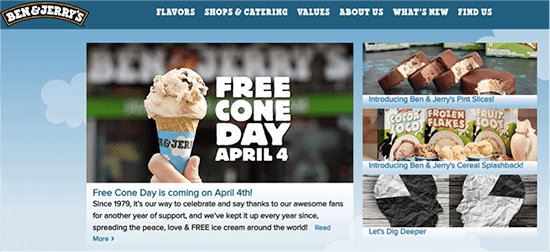
Today, Ben & Jerry’s is considered an industry leader and a premium product. Their corporate (if you can call it that) culture, charitable donations, and community service are amazing. They even have a minimum wage for employees that is nearly double the federal minimum wage.
The company is beloved by fans and employees alike. Go your own way.
Risky? Sure. But risk is not a bad thing. Playing it safe is not the way to grow and exceed even your own expectations.
“You can measure opportunity with the same yardstick that measures the risk involved. They go together.” ~Earl Nightingale, radio personality and author
Conventional wisdom is just that: conventional. It is not an absolute truth. It is not infallible. For every success with a particular approach to marketing, you can probably find another where someone did the exact opposite.
5. Worldwide101
A luxury service for a luxury crowd, Worldwide101 provides premium virtual assistants for executives, founders, and other high-profile professionals. Their services include marketing, customer service, executive admin, project management, writing, editing, bookkeeping, and more.
And with a client base that includes busy and demanding C-suite executives, you can be sure that they work hard to maintain an A+ for service, reputation, and prestige.
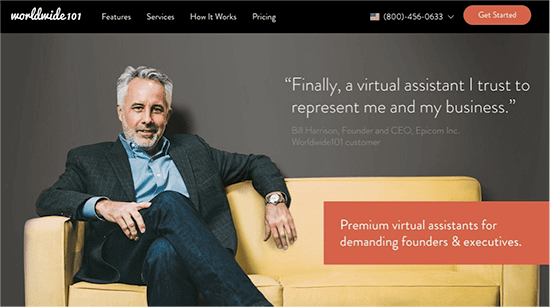
The market and demand for virtual assistants is rapidly expanding. After all, we live most of our lives online, so a digitally-accessed assistant – either real or artificially intelligent – just makes sense. The global market is expected to exceed $12 billion (with some estimates as high as $15+ billion) in the next few years.
So there’s a lot of potential profit at stake.
The conventional wisdom: Affiliate and referral marketing are surefire ways to generate leads and spread brand awareness.
Worldwide101 believed the wisdom and enthusiastically jumped in. It was disastrous for them. The campaign generated mostly poor quality leads who were uninterested in establishing a long-term relationship. Worldwide101 changed the details of the program to require that leads stick around at least three months before the affiliate bonus was paid (a threshold many of them did not reach). This angered many of the participants.
It all served to damage the company’s reputation – they appeared cheap and petty – while taking focus away from their loyal, paying customers.
When they offered a referral bonus to their clients, many of them were insulted by it, believing that it was a premium service they were happy to recommend because it was a premium service (and not because they were getting a little cash).
The entire experiment was an abysmal failure, and Worldwide101 turned its back on affiliate and referral marketing forever, conventional wisdom be damned.
They returned 100% of their focus and attention to their existing customers and to exceeding their very lofty expectations. Those delighted clients were then genuinely interested in recommending the service to their friends and colleagues.
A marketing strategy that works for most does not work for all. Consider its application to your business, your product, and your service. Is it a good fit?
6. WhatsApp
You’re already familiar with Whatsapp, one of the most popular messaging apps out there. You probably have it on your smartphone right now. And with over 1 billion users, you’re not alone.
Founded in 2009, the app boasts an impressive 700 million daily active users, 42 billion messages sent each day, 100 million daily voice calls, and a presence in 110+ countries. Rather remarkable statistics. Even more remarkable, the service is 100% free.
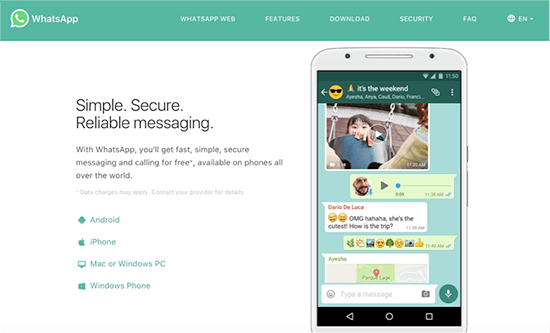
The conventional wisdom: Cultivate a large and captive audience/user base so you can monetize via ads.
With those kinds of numbers, you’d think Whatsapp would be a goldmine for its founders Jan Koum and Brian Acton. The potential for ad display monetization is enormous.
Nope. From Day One, both were dedicated to providing powerful, ad-free communication. As the service grew and gained traction, it started to capture the attention of venture capitalists. And still Koum and Acton resisted because they assumed it would mean monetizing the service.
It was only after VC Jim Goetz promised to keep it ad-free that they agreed to accept a total of $58 million in venture capital from Sequoia Capital between 2011-2013.
And still they persisted, remaining an ad-free product. Koum and Acton take a “No Ads! No Games! No Gimmicks!” approach to the app.
“When you get that message from your loved one, from your family, or from your best friend, you want to be able to reply to it right away, you don’t want to be distracted by any advertisement.” ~Jan Koum, Co-founder of Whatsapp
No ads. Ever. And the company has spent nothing on customer acquisition or advertising either, focusing entirely on improving the product and customer experience.
They didn’t try to cash in. They resisted the traditional approach. Even their decision to charge $1 per year (since removed) to offset costs – itself unconventional when similar apps were all free – only served to increase their stock and word-of-mouth growth.
They ignored the conventional wisdom. And it worked spectacularly well for them: Whatsapp was acquired by Facebook in 2014 for an astounding $19 billion.
Not bad for two guys who just wanted to deliver the best communication app they could. A quality product is worth more than a quick cash grab.
7. Limogés Jewelry
There will always be a market for jewelry. It’s one of those little luxuries that everyone loves. Established in 1895, Limogés Jewelry obviously has staying power.
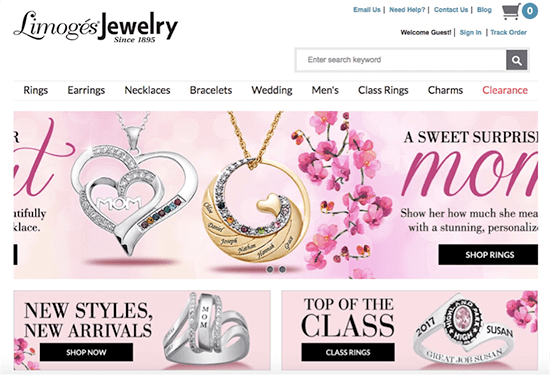
Built primarily around the main “jewelry holidays” of Christmas, Valentine’s Day, and Mother’s Day, they experience and expect peaks and valleys in their sales.
That said, like everyone else, they’d prefer a few more peaks, and a few less valleys.
The conventional wisdom: You’ve got to spend a lot to make a lot. It’s worth it to spend a few hundred targeted dollars to bring in a sale of $1000+. Go after the “big score.”
But what if your typical order value is less than that? Then the conventional approach makes much less sense. Limogés Jewelry price points are almost all under $100. For them, it’s about volume and repeat business rather than landing a few lucrative orders.
Instead, they turned their focus to the king of volume: email, and more specifically, email permission marketing.
Getting someone’s permission to send them marketing material provides better open rates, better click-through rates, and better conversions. Limogés engaged with past customers who had been radio silent for a while via email. They asked again for permission, enabling them to remove abandoned addresses and those no longer interested in their product catalogue.
It gave them a leaner, meaner mailing list. Their list shrunk by an alarming 55%, but those who remained were all engaged and ready to be sold to. Limogés also aggressively went after new subscribers and grew their list by 100-400% year-over-year.
Their campaign was simple: reconnect with customers with a promotional offer, reach out again with a second, non-promotional email that asks for their opinion, and a third that explicitly asks them whether they want to continue receiving the messages. Additionally, they created a new welcome series for new customers.
The result? Conversions increased by 24%, revenue increased by 51%, CTR improved by 71%, but overall email volume was reduced by over half. There were fewer emails being sent out, but asking permission brought in better results.
Sometimes (though not often), the volume approach is the best approach. Cast a wide net and hope that someone will bite. Volume and permission? It turns the traditional on its head.
8. Harp Boston
Social media is a must for any business in 2017 and beyond. It’s no longer something that “might” be a good idea. No matter your target demographic, they’re more than likely hanging out on the popular platforms and looking to connect with you and your brand.
Social media marketing is a crucial part of your promotion strategy if you want to be found, seen, and recognized. Just do it.
Many companies, though, take the traditional approach, and aim for as many fans, followers, and likes as possible. They tweet and post dozens of curated content items each day from a wide variety of sources, rarely taking the time to read them or respond to any comments, questions, or initiate other engagement.
The conventional wisdom: Pump out plenty of content pieces to your social media profiles. Connect with as many fans as possible. Make your social strategy easily scalable.
The Harp Boston, a popular sports bar and eatery across from TD Gardens, respectfully disagrees.
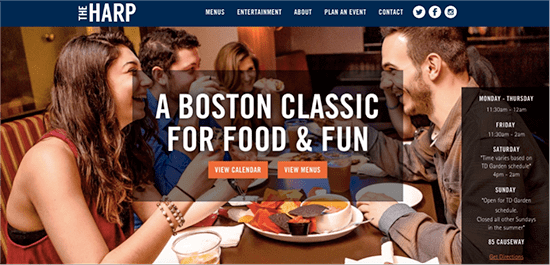
They’ve been using their Twitter account to reach out and connect one-on-one with their customers. They frequently ask questions about their experience, thank them for a visit, request feedback, and more. The result is a level of personal engagement not always seen on social media, but one that creates diehard clientele.
The Harp’s Facebook page encourages customers to post their photos, weigh in on sports, and generally share their opinions about the restaurant, their live music, and the city. And The Harp, of course, responds to it all.
Is it a scalable approach as they gain more fans and followers? Nope. But it’s working wonders for their word-of-mouth and customer loyalty. The Harp is frequently named one of the food service establishments crushing it on social media. That’s a great list to be on.
9. Softsoap
Liquid hand soap is one of those products that seems like it’s been around forever. Check out any bathroom in virtually any home, and you’re probably going to find it on the counter beside the sink in its distinctive pump bottle.
But it only broke into the home market in the 1980s. Robert Taylor and the Minnetonka Corporation released a revolutionary new product in a unique pump bottle dispenser called Softsoap, a product very recognizable to us in 2017.
At the time, the market was dominated by Procter & Gamble, Dial, and the Lever Brothers, but none of them had a liquid soap product available for the home. Minnetonka was a much smaller operation, and they feared the big guys might copy it and push them right out.
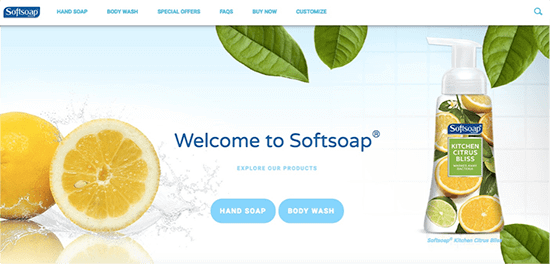
The conventional wisdom: Don’t compete outside your weight class. If you go up against the giants of your industry, you’re going to lose.
Minnetonka had a major problem. Despite the immediate popularity of Softsoap, they had no way to protect their product, as neither the soap itself or its production was patentable in any way. Brands with bigger budgets and distribution networks could easily make a copycat version and grab a huge chunk of the market.
But rather than accept that fate and a much smaller piece of the pie, Minnetonka came up with a brilliant strategy. Even though they couldn’t control the soap itself, or hope to outmarket their rivals, they realized they could control another critical element: the dispenser pump.
The pumps were patentable and closely controlled by only two manufacturers in the United States. Minnetonka took a major gamble and bought 100 million future units of the pumps from the only two sources, effectively locking the competition out until such time that Softsoap would (hopefully) have customers loyal to their brand alone.
It worked. Minnetonka sold $25 million worth in less than a year, and went on to sell the brand to Colgate-Palmolive a few years later for $61 million.
The tiny company from Minnesota took on the giants of the industry…and won.
10. De Beers
Take a lump of coal, apply tremendous pressure and heat for millions of years, and presto, you’ve got yourself a diamond. Easy.
Despite the difficulty in making them, diamonds have not been considered a rare gem since the discovery of massive diamond deposits in South Africa in the late 19th century. De Beers has been very successful since then at dominating the world market, stockpiling diamonds and selling them in strategic releases to control prices.
But for the strategy to work, they needed to control supply and demand.
The conventional wisdom: Identify how your targets view your product, and market to them accordingly.
De Beers turned the traditional wisdom upside-down. After comprehensive market research in the 1930s, they learned that Americans viewed diamonds as snobby, a luxury for the super rich. To sell more diamonds, De Beers would have to change the narrative.
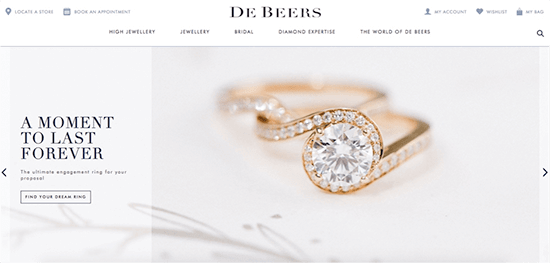
The key for them was emotion, and the ad agency hired to reinvent the diamond recognized a golden opportunity to connect diamonds and the ultimate emotion: love, marriage, and eternity.
While they didn’t invent the engagement ring, only about 10% of engagement rings contained a diamond at the time. The marketing campaign reintroduced the diamond engagement ring as the key component to any courtship. Through a coordinated effort that included celebrity endorsements, radio spots, articles, and stories about giving and receiving diamond rings, De Beers saw a 55% sales increase in just 4 years.
It didn’t take long for the public to be convinced that an engagement without a diamond ring was no engagement at all. De Beers had successfully changed the perception of diamonds from a luxury for the rich, to a necessity for anyone looking to get hitched. They controlled supply. They controlled demand.
And all because they marketed an idea that no one believed when they started. How’s that for taking a risk? A diamond is forever indeed.
What’s the most unconventional thing you’ve done for your business? Leave your thoughts in the comments below.






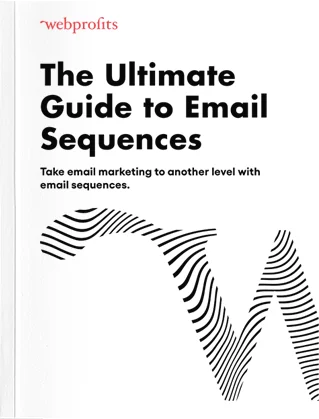
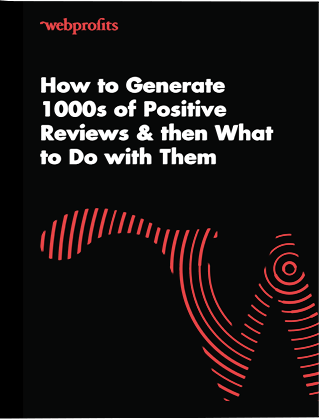
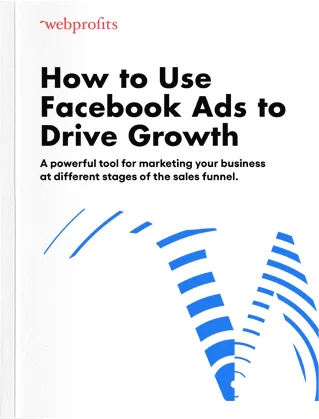
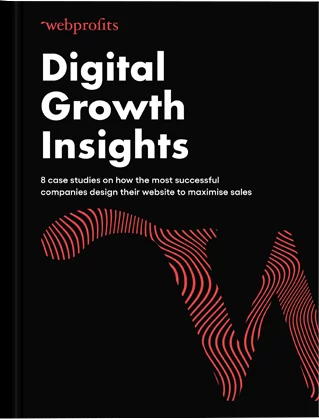
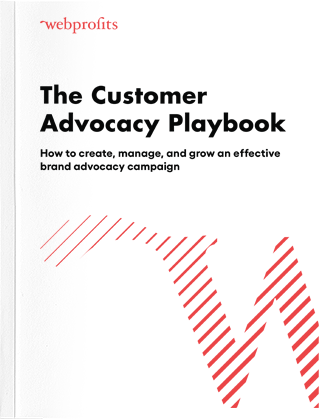


Great insights